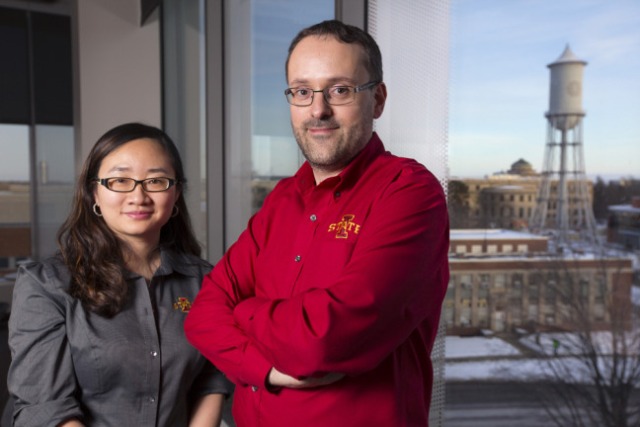Feb 11 2016
Iowa State University engineers have discovered a method where sugar is efficiently converted into a new type of nylon, by integrating a genetically engineered yeast strain with an electrocatalyst.
 Zengyi Shao and Jean-Philippe Tessonnier, left to right, are combining their expertise in biocatalytic and chemical catalytic technologies to produce a new type of biobased nylon. Photo by Christopher Gannon.
Zengyi Shao and Jean-Philippe Tessonnier, left to right, are combining their expertise in biocatalytic and chemical catalytic technologies to produce a new type of biobased nylon. Photo by Christopher Gannon.
Earlier attempts to integrate biocatalysis and chemical catalysis to develop biorenewable chemicals have generated low conversion rates. This is due to the fact residual impurities are left behind by the biological processes, harming the efficiency of chemical catalysts.
The Feb 12, 2016, issue of Angewandte Chemie International Edition features this hybrid conversion process on its cover paper. The process description is also published online.
“The ideal biorefinery pipelines, from biomass to the final products, are currently disrupted by a gap between biological conversion and chemical diversification. We herein report a strategy to bridge this gap with a hybrid fermentation and electrocatalytic process,” wrote lead authors Zengyi Shao and Jean-Philippe Tessonnier, Iowa State assistant professors of chemical and biological engineering who are also associated with the National Science Foundation Engineering Research Center for Biorenewable Chemicals (CBiRC) based at Iowa State.
[The process] opens the door to the production of a broad range of compounds not accessible from the petrochemical industry
Zengyi Shao, Assistant Professor of Chemical and Biological Engineering, Iowa State University
The engineers will have to develop a consistent conversion process that will help scale up their technology, said Tessonnier, a Carol and Jack Johnson Faculty Fellow and also an associate scientist with the U.S. Department of Energy’s Ames Laboratory.
The research was supported by Iowa State’s Plant Sciences Institute, the National Science Foundation, the Ames Laboratory, and CBiRC.
Shao’s team has developed genetically engineered yeast – “a microbial factory,” she said – that helps ferment glucose into muconic acid. The researchers used metabolic engineering techniques to enhance the yield of the acid. Tessonnier’s team introduced lead into the mix, instead of using a purification process. This was followed by applying a small voltage to convert the acid. As a result hydrogen is added to the mix, developing 3-hexenedioic acid.
The team developed bio-based, unsaturated nylon-6,6 after a simple process of separation and polymerization. This nylon has an additional double bond that is used to modify properties of the polymer.
The engineers suggest that the hybrid conversion technology provides a number of benefits. The reaction is carried out at room temperature, and it uses an abundant and inexpensive metal, instead of high-priced elements like platinum or palladium. The other compounds used in the reaction are developed from water.
We gave it a try and it worked immediately. The process does not need additional chemical supplement, and it works amazingly at ambient temperature and pressure, which is very rare for this type of process.
Jean-Philippe Tessonnier, Assistant Professor of Chemical and Biological Engineering, Iowa State University
Tessonnier and Shao working together illustrates the CBiRC way, which refers to the aspect of incorporating the tools of chemists and biologists to create hybrid technologies that help develop unique biorenewable chemicals. The resulting collaboration and CBiRC’s main goal are leading to very sophisticated research papers and discoveries.
“CBiRC seeds these new ideas and concepts,” Tessonnier said. “It’s all about integration.”
“CBiRC provides the nurturing environment to brainstorm what can be done with the expertise owned by two groups of experts who are trained through very different routes. This vision of these fields working together is going to grow. Students educated through such interdisciplinary research projects will definitely stand out with a broader vision in the biorenewable industry.
Zengyi Shao, Assistant Professor of Chemical and Biological Engineering, Iowa State University